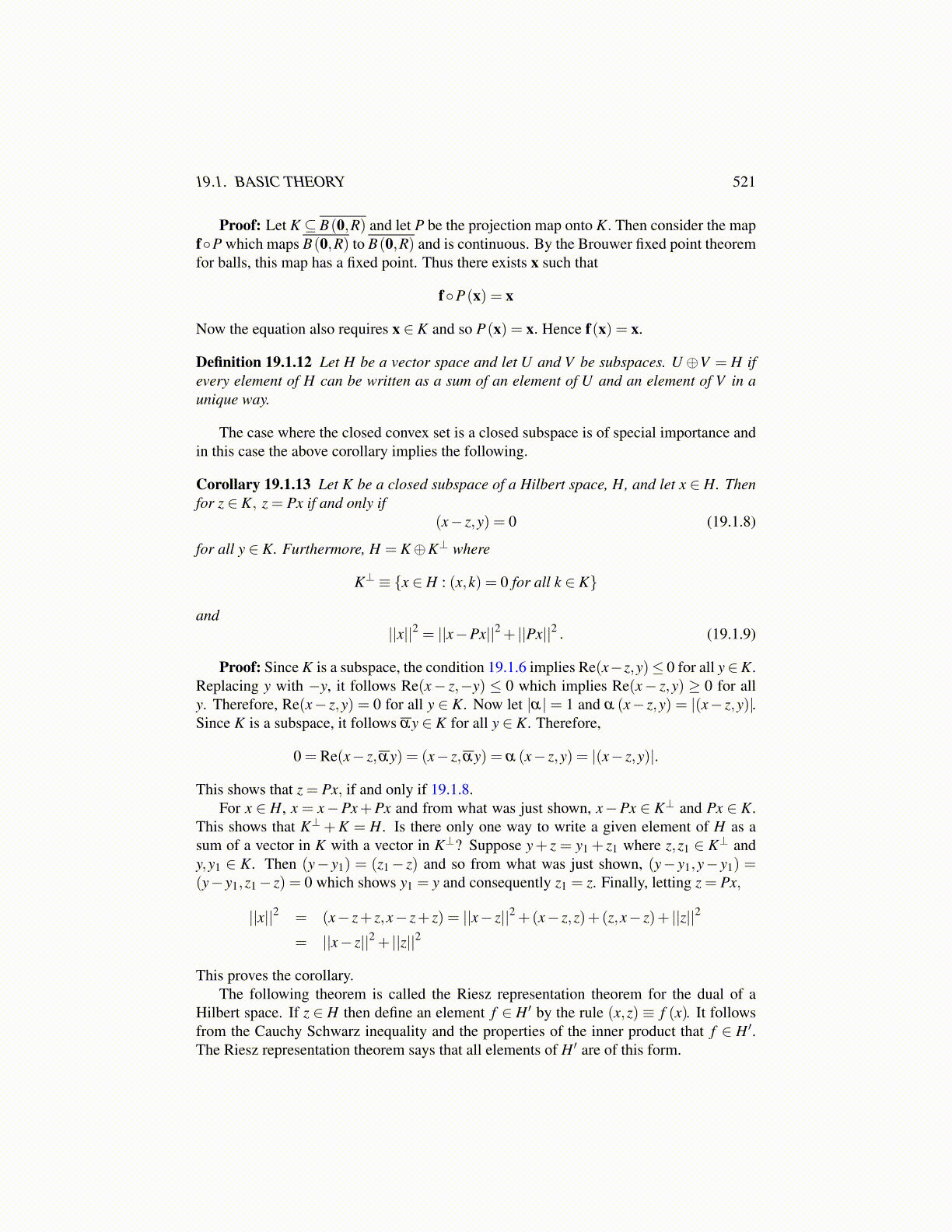
19.1. BASIC THEORY 521
Proof: Let K ⊆ B(0,R) and let P be the projection map onto K. Then consider the mapf◦P which maps B(0,R) to B(0,R) and is continuous. By the Brouwer fixed point theoremfor balls, this map has a fixed point. Thus there exists x such that
f◦P(x) = x
Now the equation also requires x ∈ K and so P(x) = x. Hence f(x) = x.
Definition 19.1.12 Let H be a vector space and let U and V be subspaces. U ⊕V = H ifevery element of H can be written as a sum of an element of U and an element of V in aunique way.
The case where the closed convex set is a closed subspace is of special importance andin this case the above corollary implies the following.
Corollary 19.1.13 Let K be a closed subspace of a Hilbert space, H, and let x ∈ H. Thenfor z ∈ K, z = Px if and only if
(x− z,y) = 0 (19.1.8)
for all y ∈ K. Furthermore, H = K⊕K⊥ where
K⊥ ≡ {x ∈ H : (x,k) = 0 for all k ∈ K}
and||x||2 = ||x−Px||2 + ||Px||2 . (19.1.9)
Proof: Since K is a subspace, the condition 19.1.6 implies Re(x−z,y)≤ 0 for all y∈K.Replacing y with −y, it follows Re(x− z,−y) ≤ 0 which implies Re(x− z,y) ≥ 0 for ally. Therefore, Re(x− z,y) = 0 for all y ∈ K. Now let |α| = 1 and α (x− z,y) = |(x− z,y)|.Since K is a subspace, it follows αy ∈ K for all y ∈ K. Therefore,
0 = Re(x− z,αy) = (x− z,αy) = α (x− z,y) = |(x− z,y)|.
This shows that z = Px, if and only if 19.1.8.For x ∈ H, x = x−Px+Px and from what was just shown, x−Px ∈ K⊥ and Px ∈ K.
This shows that K⊥+K = H. Is there only one way to write a given element of H as asum of a vector in K with a vector in K⊥? Suppose y+ z = y1 + z1 where z,z1 ∈ K⊥ andy,y1 ∈ K. Then (y− y1) = (z1− z) and so from what was just shown, (y− y1,y− y1) =(y− y1,z1− z) = 0 which shows y1 = y and consequently z1 = z. Finally, letting z = Px,
||x||2 = (x− z+ z,x− z+ z) = ||x− z||2 +(x− z,z)+(z,x− z)+ ||z||2
= ||x− z||2 + ||z||2
This proves the corollary.The following theorem is called the Riesz representation theorem for the dual of a
Hilbert space. If z ∈ H then define an element f ∈ H ′ by the rule (x,z) ≡ f (x). It followsfrom the Cauchy Schwarz inequality and the properties of the inner product that f ∈ H ′.The Riesz representation theorem says that all elements of H ′ are of this form.